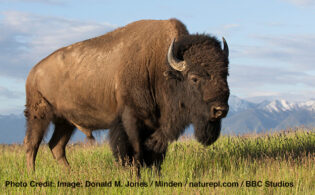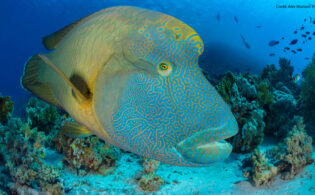Universal Television Alternative Studio’s Toby Gorman, BBC Studios Natural History Unit’s Mike Gunton and series editor Holly Spearing took MIPTV delegates behind the scenes of the big-budget event series The Americas at a session today moderated by World Screen’s Anna Carugati.
The ten-part blue-chip production, narrated by Tom Hanks with a score from Oscar winner Hans Zimmer, is set to air on NBC in prime time in 2025. The MIPTV panel today saw Gorman, president of Universal Television Alternative Studio; Gunton, creative director at BBC Studios’ storied Natural History Unit (NHU); and Spearing, series editor at the BBC, showcase clips from the series while sharing insights into its five-year journey to the screen with Carugati, editor-at-large at World Screen.
NBC commissioned the series, then known as The New World, back in 2020. At the time, Gorman said, the team at NBCUniversal was beginning to explore the premium factual space. “As we were agreeing across the studio and the network that this is a swing we wanted to take, Mike Gunton happened to knock on our door. Kismet is the answer to how this came about!”
Gunton had long wanted to spotlight the natural wonders of the Americas, and knew he needed a partner of significant size to collaborate on the production. “For some reason, no one had ever done a full job on the whole of the Americas. The scale was so huge, I thought, there aren’t many places that will be able to take this on.”
Gorman noted, “We would have never thought about doing it in our backyard. That’s what was so special about the concept Mike brought to us.”
Gunton added: “There’s nowhere on Earth that has this range; its head is almost in the Arctic, and its toes almost in the Antarctic. It splits the two greatest oceans on the planet: the Atlantic and the Pacific. And it crosses every latitude. It goes through the tropics, the equator, deserts and icecaps; you can’t imagine anything more diverse. As a wildlife filmmaker, it’s all about superlatives and [The Americas] has all the superlatives. It doesn’t have elephants, but that’s about it! The biggest trees and rivers, the deepest canyons, and A-list animals of an extraordinary nature. It was just a dream to do it.”
To showcase all of that diversity, “we wanted to show things that people have never seen before,” Gunton said. “It’s all about firsts. Now that’s tough. The low hanging fruit has all been taken. The difficult things are left. One of the things we’ve been most gratified about is we have been able to do things that people have never seen before, in ways they’ve never seen before.”
Gunton then introduced a clip from the episode on the Andes showcasing its use of drone filmmaking techniques to capture the journey of a spectacled bear making a treacherous journey down a mountain with her young cubs. “You can’t get up there with a camera; the only way you could film it was with a drone.”
Other technological advancements deployed in the series include the use of robot cameras, allowing the producers “to get into the world of animals in a way that I don’t think we’ve done before. That’s super important because the whole ethos of The Americas is to get you deep into the secret lives of these animals, to experience what they experience and to see things that your eyes could never see.”
The next clip showcased the technology, developed over two years, used to film sperm whales in the depths of the Caribbean Sea, with Gunton noting: “We have revealed, for the first time, what happens when sperm whales go hunting.”
Gorman added: “We really wanted to ensure that we were doing something new in every episode. There is an 11th episode of behind the scenes of all the lengths the teams went to to acquire this groundbreaking footage.”
Carugati then asked the panelists about how each episode was crafted, and the adjustments that needed to be made along the way. “We planned a really long way in advance,” Spearing said. “For a project of this scale, it’s pretty much a year of planning to lock down all of our stories and locations. We wanted to get to the key habitats within all of our episodes, finding those animals that were intrinsically linked to them, like the black bears in swamps in Louisiana and sea wolves on the West Coast. Of course we were looking for newness, so we worked hard with our network of scientists all across the Americas, building those relationships. That really paid off. We wanted to tell relatable stories; ones that resonated with people. We prep and write our scripts. Of course, animals don’t read scripts. We had planned for a year to go film bison, got out there and every single bison, hundreds of them, had all left! We had to think on our feet, scramble to a new location, react on the ground. But some of greatest joys have come from the things we didn’t expect,” including never-before-seen footage of a male hummingbirds fighting. “Some of those things that unfold in the field are exactly the things you want.”
“Nature is eternally surprising,” Gunton added. “We have a sequence in our West Coast episode about blue whales. I had never seen anything like it, and I don’t think any human eye has seen anything like this. When you watch the episode, you’re going to see something that is one of the true wonders of the world.”
All told, the series encompasses 180 different expeditions, Gunton said, “each of which has to be self-contained.”
When mulling who to enlist as narrator, the team at NBCUniversal wanted to find “the American version of [David] Attenborough,” Gorman said. “We wanted to go as big as possible.” Tom Hanks was the team’s first choice. “We got a very fast yes,” Gorman said. “The scale and what we were trying to achieve resonated with him. Proudly, it’s the first unscripted thing he’s ever narrated.”
Gunton said he too thought of Hanks when plotting his initial pitch. “His talent is so immense that he can turn his voice and delivery to every single nuance in these stories. It’s very hard to pull off the gravitas of telling important, serious stories; some are dramatic, some poignant and some really funny. It also has a warmth that connects with how you feel what the animals are feeling. It’s a great skill.”
Following a clip about a male owl searching for a mate, Gorman noted: “This is such a good example of what the key differentiator is with this series. In order for this project to work on NBC prime-time broadcast, we knew it had to be entertainment-first. It had to have comedy and emotion. It had to feel like a mini-movie.”
Legendary composer Hans Zimmer was enlisted to score the production. “He thinks it’s one of the best things he’s ever written,” Gunton said. “The music is intrinsic to getting the tone, emotion and enjoyment.”
As to the level of NBCUniversal’s investment in the series, Gorman responded: “It was expensive! There was so much risk, we wanted to many firsts, we knew it would take so much time. This is, as far as I understand, the most expensive unscripted project in NBCUniversal’s history. It’s a big swing for us. We’re confident it’s been worth it.”
As the session came to a close, Gunton noted: “When you watch The Americas, I think you will laugh, cry, be amazed, be wowed, but I think you’ll also want to care about this extraordinary place that we have that runs from right up in the north all the way down to the south. It’s one of the greatest places on planet Earth.”
 TVREAL
TVREAL






